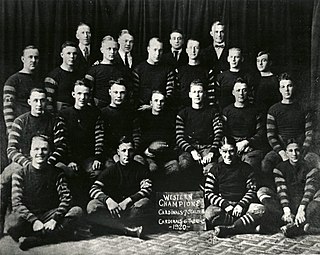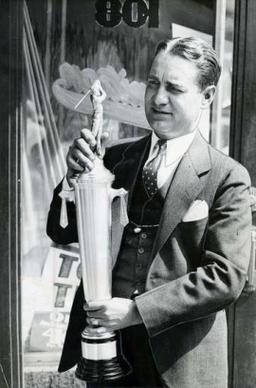The Akron Pros were a professional football team that played in Akron, Ohio from 1908 to 1926. The team originated in 1908 as a semi-pro team named the Akron Indians, but later became Akron Pros in 1920 as the team set out to become a charter member of the American Professional Football Association. Fritz Pollard, the first black head coach in the NFL, co-coached the Akron Pros in 1921. Paul Robeson played for the team in 1921 as well. He was among the earliest stars of professional football before football became segregated from 1934 to 1946. In 1926, the name was changed back to the Akron Indians, after the earlier semi-pro team. Due to financial problems, the team suspended operations in 1927 and surrendered its franchise the following year.
Buffalo, New York had a turbulent, early-era National Football League team that operated under multiple names and several different owners between the 1910s and 1920s. The early NFL-era franchise was variously called the Buffalo All-Stars from 1915 to 1917, Buffalo Niagaras in 1918, the Buffalo Prospects in 1919, Buffalo All-Americans from 1920 to 1923, Buffalo Bisons from 1924 to 1925 and in 1927 and 1929, and the Buffalo Rangers in 1926. The franchise, which was experiencing financial problems in 1928, did not participate in league play that season.
The 1920 APFA season was the inaugural season of the American Professional Football Association, renamed the National Football League in 1922. An agreement to form a league was made by four independent teams from Ohio on August 20, 1920, at Ralph Hay's office in Canton, Ohio, with plans to invite owners of more teams for a second meeting on September 17, 1920. The "American Professional Football Conference" (APFC) was made up of Hay's Canton Bulldogs, Akron Pros, the Cleveland Tigers and the Dayton Triangles, who decided on a six-game schedule to play each other at home-and-away, an agreement to respect each other's player contracts, and to take a stand against signing college students whose class had not yet graduated.

The 1920 season was the Decatur Staleys 2nd season of existence, the first professional season of the franchise that would go on to be known as the Chicago Bears and their first under head coach George Halas, competing in the newly formed American Professional Football Association.
The Ed Thorp Memorial Trophy was the trophy awarded to the champions of the National Football League (NFL) from 1934 through 1967. The trophy was named after Ed Thorp, a noted referee, rules expert, sporting goods dealer, and friend to many of the early NFL owners. Thorp died in June 1934, and a large, traveling trophy was made later that year. It was to be passed along from champion to champion each season with each championship team's name inscribed on it.

The 1920 Akron Pros season was the franchise's inaugural season with the American Professional Football Association (APFA) and twelfth total season as a team. The Pros entered the season coming off a 5–5 record in 1919 as the Akron Indians in the Ohio League. The Indians were sold to Art Ranney and Frank Nied, two businessmen, to help achieve a better record and crowd. Several representatives from the Ohio League wanted to form a new professional league; thus, the APFA was created.
The 1920 Buffalo All-Americans season was the franchise's inaugural season with the American Professional Football Association (APFA), an American football league, and fifth total as a team. The All-Americans entered 1920 coming off a 9–1–1 record in 1919 as the Buffalo Prospects in the New York Pro Football League (NYPFL). Several representatives from another professional football league, the Ohio League, wanted to form a new national league, and thus the APFA was created.

The 1920 Chicago Cardinals season was the Cardinals' inaugural season in the American Professional Football Association. The team finished 6–2–1, earning fourth in the league. Their final two games of the season against the Chicago Stayms Foresters were played after the APFA season was officially over and did not count towards the standings.
The 1920 Chicago Tigers season was their sole season in the National Football League. The team finished 2–5–1, tying them for eleventh in the league.
The 1920 Cleveland Tigers season was the franchise's inaugural season in the American Professional Football Association (APFA) and fifth total as an American football team. The Tigers entered the season coming off a 5-win, 2-loss, 2-tie (5–2–2) record in 1919. After the 1919 season, several representatives from the Ohio League, a loose organization of professional football teams, wanted to form a new professional league; thus, the APFA was created.
The 1920 Columbus Panhandles season was the franchise's inaugural season in the American Professional Football Association (APFA)—later named the National Football League. The season concluded with the team going 2–6–2 and finishing 13th place in the APFA standings. The Panhandles entered the season after a 3–6–1 record in 1919. The team opened the 1920 season with a loss to the Dayton Triangles, and the Panhandles lost five straight until a victory over the Zanesville Mark Grays. Not a single player was on the All-Pro list.
The 1920 Dayton Triangles season was the franchise's inaugural season in the American Professional Football Association (AFPA)—later named the National Football League. The Triangles entered the season coming off a 5–2–1 record in 1919 in the Ohio League. After the 1919 season, several representatives from the Ohio League wanted to form a new professional league; thus, the APFA was created. A majority of the team stayed from the 1919 team, including the coaching staff, while two players left the team.
The 1920 Hammond Pros season was the franchise's inaugural season in the American Professional Football Association (APFA) and second as an American football team. The Pros entered 1920 coming off a 4-win, 2-loss, 3-tie (4–2–3) record in 1919 as an independent team. Several representatives from another professional football league, the Ohio League, wanted to form a new national league, and thus the APFA was created.
The 1920 Muncie Flyers season was the franchise's inaugural season in the American Professional Football League (APFA)—later named the National Football League. The Flyers entered the season coming off a 4–1–1 record in 1919. Several representatives from the Ohio League wanted to form a new professional league; thus, the APFA was created. The 1920 team only played in one game that counted in the standings: a 45–0 loss against the Rock Island Independents. This game and the Columbus Panhandles–Dayton Triangles on the same date is considered to be the first league game featuring two APFA teams. The Flyers tried to schedule other games, but the opponents canceled to play better teams. As a result, the Flyers had to play the rest of the season's game versus local teams. In week 10, the Flyers won a game against the Muncie Offers More AC for the Muncie City Championship. No players from the 1920 Muncie Flyers were listed on the 1920 All-Pro Team, and no player has been enshrined in the Pro Football Hall of Fame.
The 1920 Rochester Jeffersons season was the franchise's inaugural season in the American Professional Football Association (APFA) and thirteenth as an American football team. The Jeffersons entered 1920 coming off a six-win, two-loss, two-tie (6–2–2) record in the New York Pro Football League (NYPFL) where it lost the championship game to the Buffalo Prospects. Several representatives from another professional football league, the Ohio League, wanted to form a new national league, and thus the APFA was created.
The 1920 Rock Island Independents season was the American football franchise's thirteenth season and inaugural season in the American Professional Football Association (APFA). The Independents hosted first ever APFA/National Football League contest on September 26, 1920. After the AFPA had been formed on September 17, 1920, Douglas Park was the venue as the Independents hosted the St. Paul Ideals, winning 48-0 in the new league's first contest.

Francis Theodore Nied was a founder of the American Professional Football Association, as well as the owner of the Akron Pros and, as the team became known as in 1926, the Akron Indians.

Arthur Fobare Ranney was a co-founder of the American Professional Football Association, as an owner of the Akron Pros, one of the league's charter teams. The Pros were renamed the Akron Indians in 1926.
The 1921 NFL Championship controversy, known among Buffalo sports historians and fans as the Staley Swindle, is a dispute in which the Buffalo All-Americans unintentionally surrendered the 1921 APFA Championship title to the Chicago Staleys. The controversy began at the conclusion of the 1921 season, when the All-Americans finished the season with the best record in the American Professional Football Association. However, after losing what the All-Americans owner had intended to be an exhibition game to the Staleys on December 4, 1921, the All-Americans lost their title to Chicago on a tiebreaker.




